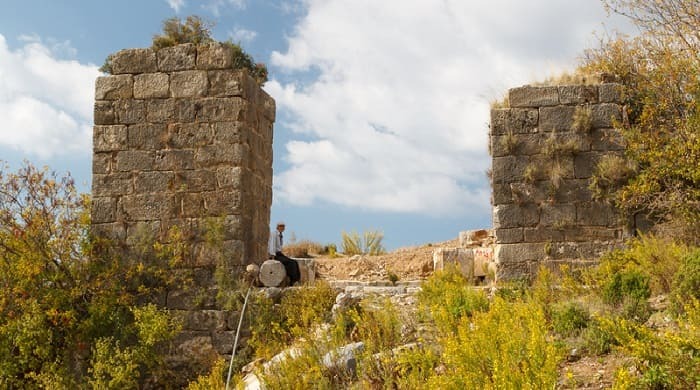

Aytap is a land of many wonders, with a rich history that stretches back through the ages. Aytap, earlier known as Iotapa, is a port city in Cicilia located in Southern Turkey. King Antiochus IV of Commagene established it in 52 CE. From the ruins of ancient civilizations to the bustling markets of modern-day cities, Aytap is a land shaped by its history and enriched by its diversity.
The early history of Cilicia is a fascinating tale of a land that was shaped by the ebb and flow of empires and the migration of ancient peoples. Situated at the crossroads of Asia, Europe, and the Middle East, Cilicia was a gateway to the ancient world, a place where diverse cultures and traditions converged.
According to the ancient Greek historian Herodotus, Cilicia was once home to a powerful kingdom known as the Khilikku, whose people were feared for their skills as warriors and seafarers. The Khilikku were eventually conquered by the Persians, who incorporated Cilicia into their vast empire.
In the words of the historian Michael C. Astour, "Cilicia was a melting pot of cultures, a place where East and West met and intermingled." This cultural mixing gave rise to a unique blend of traditions, which is reflected in the region's art, architecture, and cuisine.
The Cilician pirates were a formidable force, feared by traders and sailors alike. Their activities ranged from small-scale raids on coastal settlements to large-scale attacks on Roman ships, which brought them into conflict with the mighty Roman Empire.
According to the Roman historian Livy, the Cilician pirates were "the most cruel and most savage of all the robbers of the sea." They were known for their brutality and their willingness to take on any ship, regardless of its size or strength. Their actions were a constant threat to Rome's maritime trade, which relied on safe passage through the Mediterranean.
In response to this threat, Rome launched a series of military campaigns against the Cilician pirates. The most successful of these campaigns was led by the Roman general Pompey the Great, who was tasked with putting an end to the pirate menace once and for all.
Antiochus IV, the Seleucid king of Syria, was a controversial figure in ancient history. He was known for his ruthless tactics and his attempts to impose Hellenistic culture on the people of his kingdom. One of his most significant actions was his decision to marry Iotapa, a princess from the neighboring kingdom of Commagene.
According to the ancient historian Josephus, Antiochus IV fell in love with Iotapa and decided to marry her, despite the fact that she was already betrothed to another man. The marriage caused a great deal of controversy, as it was seen as a violation of the traditional customs of the region.
The marriage between Antiochus IV and Iotapa was short-lived, as Antiochus IV died soon after the wedding. However, the marriage had significant political implications, as it solidified the ties between the Seleucid and Commagene kingdoms.
Antiochia ad Cragum was a prominent ancient city located in the southern region of Turkey. The city was built by the Seleucid king Antiochus IV, who named it after himself. The city was later inhabited by the Romans and played an important role in the region's history.
One of the most interesting aspects of Antiochia ad Cragum's history is its association with the powerful queen Iotapa Philadelphos. Iotapa was the daughter of the Commagene king Sames II and was married to the Roman prince Alexander in 10 AD. She was renowned for her beauty, intelligence, and political acumen, and she played a significant role in the affairs of the Roman Empire.

Ruins of the ancient town Antiochia ad Cragum
One of the main problems Aytap faced with Rome was the constant threat of attack. The Roman Empire was expanding rapidly during this time, and Aytap was seen as a potential target for Roman conquest. This led to frequent military campaigns and skirmishes between the two powers.
Another issue was the tension caused by cultural and religious differences. Aytap was an important center of Hellenistic culture, while Roman traditions predominantly influenced Rome. This led to clashes over issues such as language, customs, and religious practices.
Historical evidence suggests that these conflicts had a significant impact on Aytap's development. The city's fortifications and defensive structures, for example, were built in response to the threat of Roman invasion. The city also suffered from economic instability, as trade and commerce were disrupted by the ongoing conflicts.
Aytap was a remarkable ancient city that played an important role in the history of southeastern Anatolia. The city's strategic location, rich cultural heritage, and commercial importance made it a hub of trade, commerce, and political activity. However, Aytap faced many challenges throughout its history, including conflict with neighboring powers, economic instability, and social and cultural tensions. Despite these challenges, Aytap continued to thrive and grow, leaving behind a rich legacy that can still be seen in the city's ruins and historical artifacts.
Q1. What is the significance of Aytap today?
Ans. Today, the ruins of Aytap offer a glimpse into the city's rich past and the challenges it faced as it navigated the complex political landscape of the ancient world.
Q2. WHat is the most famous monumental structure of Aytap?
Ans. One of the most famous monuments of Aytap is the Temple of Venus, which was a significant religious and cultural center during the Roman period.
Q3. How did Aytap get its name?
Ans. The name "Aytap" is thought to have originated from the Hittite word "Attabi," which means "horse." This is likely a reference to the region's long history of horse breeding and equestrian culture.